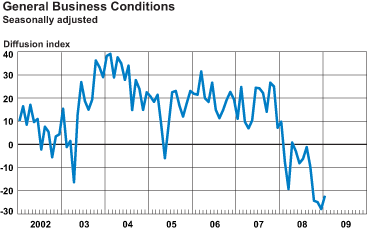January 2009 Report
Survey Indicators
Seasonally Adjusted

The Empire State Manufacturing Survey indicates that conditions for New York manufacturers continued to deteriorate in January. The general business conditions index rose several points but, at -22.2, remained near recent record lows. The new orders, shipments, and unfilled orders indexes also remained near their recent record lows. The indexes for prices paid and prices received were negative for a second consecutive month, and employment indexes remained deep in negative territory for a third consecutive month. Future indexes dropped sharply; the future general business conditions index, along with a number of other forward-looking indicators, fell below zero for the first time in the survey’s history.
In response to a series of supplementary questions (see Supplemental Report tab),on employment changes, respondents predicted that their firms’ workforces would decline by 2.4 percent on average in the upcoming year—an expectation that contrasted with the slight increase anticipated in an identical survey conducted last April. A larger proportion of firms—40 percent, up from 29 percent in last year’s survey—anticipated declines in the total number of workers; increases were expected by 45 percent of those surveyed this year, about the same percentage as last year. The average number of layoffs anticipated in the year ahead climbed from 2 percent of workers in the April 2008 survey to nearly 5 percent in the current survey. Finally, the average workweek was expected to be modestly shorter (39.9 hours) in twelve months than it is now (41.0 hours).
General Business Conditions Index Remains Near Recent Lows
The general business conditions index rose 6 points from its December record low but, at -22.2, remained deep in negative territory for a fourth consecutive month. Eighteen percent of respondents reported that conditions had improved in January, while 40 percent reported that conditions had deteriorated. The new orders index, at -22.8, held near its December level. The shipments index was also little changed from December, at -13.1, and the unfilled orders index was also essentially unchanged at -26.1. The delivery time index dropped sharply, to -18.2, and the inventories index fell to -19.3.
Price Indexes Remain Negative
The indexes for both prices paid and prices received remained negative for a second consecutive month. After falling a precipitous 28 points last month, the prices paid index fell another 11 points in January, to -18.2; the index set a new record low, with 33 percent of respondents reporting that prices had dropped. After turning negative last month, the prices received index rose several points but remained below zero at -3.4. Employment indexes remained well below zero for a third consecutive month. The index for number of employees fell to -26.1; the average workweek index inched up to -23.9.
Future Indexes Turn Negative for the First Time
The future general business conditions index fell below zero for the first time in the survey’s history—an indication that more manufacturers expect conditions to worsen over the next six months than to improve. The index fell 22 points, to -4.0, with roughly 33 percent of respondents expecting improved conditions over the next six months and 37 percent expecting a deterioration. The future new orders, shipments, and unfilled orders indexes all dropped sharply and turned negative for the first time. The future prices paid and prices received indexes held just above zero. The future number of employees index fell 12 points to -11.3, a record low, while the future average workweek index remained slightly below zero. The capital expenditures index held firm at -11.4, and the technology spending index fell to a record low -15.9.










